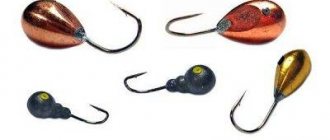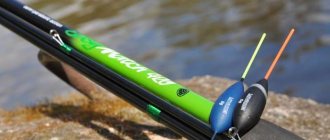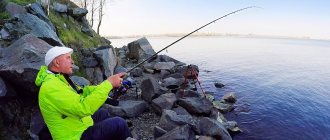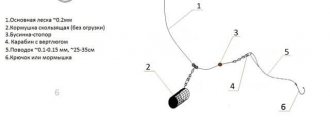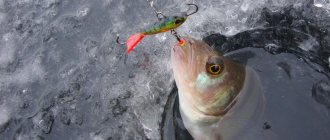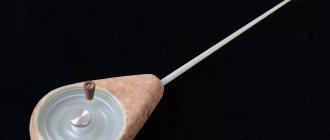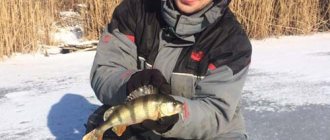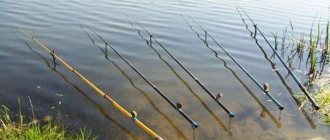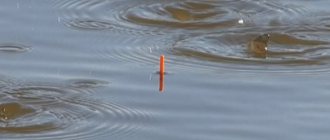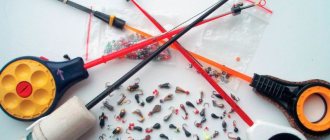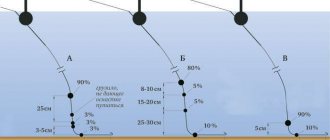- Fishing with a summer jig with a reel
- Fishing with a float and jig in the summer at great depths
- Fishing with a summer jig with a side nod from a plastic bottle
Fishing with a jig from the shore in the summer is considered quite sportive fishing.
This type of gear allows you to fish even during the spawning period, when most fishing gear is prohibited. In addition, with its help you can catch much more fish than with a regular float rod. Fishing is carried out both with blind equipment - line along the length of the rod, and with a reel. Blind tackle is mostly used for fishing from the shore or by wading, since it has less mass and is easier to hold in the hand during the day. The reel is most often used when fishing from a watercraft.
Rod
In winter, fishermen, using almost weightless fishing rods with light tackle, can play with bait with great frequency and only with movements of the hand. But when fishing in the summer, playing with a jig located at a considerable distance from the angler is both difficult and difficult.
Although the telescopic rod is made of carbon fiber to lighten the weight, holding and oscillating with such a “six-meter stick”, made even using modern technology and modern materials, is not an easy task, especially if you do it for several hours in a row. A six- to seven-meter rod is the optimal choice: with a longer length, it becomes very difficult to control the tackle, and if the rod is short, then you can only fish directly near the shore, where it is impossible to catch serious fish.
When fishing with a jig, skillful play with tackle is the main component of success. But casting distance is also important. There are no special rods for jig tackle, so each angler must choose for himself a rod of the required length, most suitable for his fishing conditions.
You can even use a spinning rod to catch bait such as a jig.
One of the options for a side nod at the end of the rod
Classic Equipment Snap
The traditional rigging of a winter float rod for roach involves fishing from the bottom. This type of equipment can only be fished in standing or weakly flowing water bodies.
Since ice fishing for roach is rarely carried out at depths of more than 6 m, the carrying capacity of the float should not exceed 1.5 g. If you install a float with a higher carrying capacity, the tackle will be less sensitive.
The thickness of the main line should be from 0.10 to 0.14 mm. You should not use fishing lines of very small diameters, as they are more susceptible to tangling, which will cause the angler a lot of inconvenience while fishing. Using a fishing line that is too thick will make the entire tackle excessively rough, unable to respond to cautious fish bites. It’s good if the main line is dark in color. Dark monofilament is much more visible in the snow, which is very convenient for the fisherman.
As a rule, leashes are not used in traditional rigging. This is due to the fact that the hook and sinker lie on the bottom. In this case, the thickness of the monofilament is not critical, and you can do without a leash.
Particular attention should be paid to the distribution of weights on the fishing line. The main set of sinkers are placed 80 cm above the hook, which almost completely sink the float. A small sinker, which is placed 3 cm from the hook, should completely submerge the float under water. The total mass of the sinkers should be slightly greater than the total carrying capacity of the float.
During the fishing process, a hook and a sinker are located at the bottom, and the main set of sinkers is located at a considerable distance from the hook, which allows you not to alert the fish. When biting, the roach retracts the hook with bait, thereby lifting the sinker from the bottom. This action is instantly transmitted to the float, which, when bitten, begins to slowly float up.
Classic float tackle has a number of undeniable advantages over jig tackle:
- The bite alarm works great regardless of wind strength,
- the large mass of the equipment allows it to be lowered to the desired depth faster,
- You can fish with float tackle even in severe frost.
Since bloodworms are considered the most catchy bait on reservoirs without current, you should not use hooks larger than size 16. The use of small hooks allows the bloodworm to remain alive and move actively, which attracts the fish more and makes its bites more confident.
The classic rig works great not only when fishing for roach, but also when hunting for fish such as crucian carp and bream.
Winter stationary fishing
Winter fishing with a fishing rod may also be preferable not only because of the angler’s personal preferences for the float. The choice of method is determined by the reservoir itself. Fishing with a winter fishing rod with a float is used mostly for bottom fish - bream, crucian carp. It’s still better to catch perch using an active jig. Roach, depending on conditions, responds well to both fishing methods. Stationary fishing with a winter fishing rod is a separate large area of fishing, with its own nuances and features of tactics, technique and equipment.
Fishing from a boat with a winter fishing rod
Few people today practice using winter fishing rods for fishing from a boat. However, this technique has been known for a very long time and is often highly effective, but it is necessary to choose the right gear.
Some features of this process are given below:
- Classic winter balalaika jigs can be an effective option, but using them is extremely inconvenient due to the need to constantly hold your hand with the tackle over the side of the boat.
- Small telescopic rigs with rings , which are used for winter ring fishing from the shore, are the most common option.
- The hybrid option , when a sufficiently long whip or carbon tip for Bolognese gear is attached to a winter fishing rod, is not only effective, but also the most convenient way of such fishing.
Rigging a fishing rod with a side nod
Nods on fishing rods with jig tackle can be lateral or straight. On long rods, side nods are more visible, which is why they are usually used.
In general, all fishing rods must have their own nods, which can be lavsan, steel or spring.
Side nods
The length of the side nods when summer fishing using jigs is chosen depending on the length of the rod. The longer it is, the longer the side nod it should be equipped with. A correctly chosen nod prevents sudden vibrations and allows you to make smooth and floating play with the jig. For example, if your rod is 6-7 meters long, then the side nod for it should be about 20 cm long.
Telescopic fishing rod with side nod
When checking the correct choice of nod, you need to keep in mind that due to the action of the weight of the jig, the nod is usually in a horizontal position or goes down slightly, while without bait the nod bends slightly upward.
And since the jigs used for fishing can have different weights, then the nods should be chosen to pair with them, also different in length. The option of adjusting the size of the nod during fishing is inconvenient, since this requires more time than the operation of replacing it with another nod. Therefore, when going fishing, it is best to collect many different nods with different lengths.
It is useful to put multi-colored signaling devices on the tips of the nods, made of some light, brightly colored materials, for example, foam or pieces of colored tubes.
Poachers who caught 317 kg of fish were not punished
A group of fishermen revealed the name of the secret bait during interrogation.
Category: regional news.
MORE →
A fishing rod with a side nod is a rather unusual tackle, in which, instead of a float, a “side nod” is attached to the edge of the rod, and a summer jig is used as bait. Fishing with a side nod is quite popular among our anglers, as it allows you to fish in areas densely covered with aquatic vegetation. Even if we take a fly rod, which is also designed for fishing in dense vegetation and hard-to-reach places, there is still a high probability of the float getting caught on obstacles. At the same time, the jig freely reaches the bottom. Another plus is that the nod gives play to the jig, even with a slight swing of the rod.
A fishing rod with a side nod is used to catch roach, bream, carp and crucian carp. If you additionally bait the jig hook with animal bait (bloodworm, caddis larva, maggot), then there is a chance of catching a pike or pike perch; a perch can also bite on a reelless jig.
For perch, pike, pike perch
When fishing for pike, perch and pike perch with a winter fishing rod, use a jig, spoon or balancer. For catching perch, all three types of bait are used; for pike and pike perch, the last two are a balancer and a vertical spoon.
Tackle with a nod and a jig.
Fishing with a jig with a nod is the most common during winter fishing. Moreover, the jig is used both with and without an attachment. In addition to perch, roach, bream, silver bream and most other white fish are caught with this tackle.
Healthy ! Top 10 most catchy jigs for perch for winter fishing
Selection of equipment elements
Fishing with a winter fishing rod with a jig and a nod is a fairly active fishing method that requires constant play with the bait, so the tackle should be light.
- For such a winter fishing rod, choose a rod whose handle is made of lightweight materials, cork, various dense foams, lightweight plastics, coated with thermal insulating material that does not cool your hands when fishing.
- Note! For more than 30 years, many fishermen have been using a fishing rod, popularly nicknamed “balalaika”, with a reel embedded in a round or oval-shaped handle, as a light, industrial fishing rod for winter jig fishing. It has proven itself excellent in both sports and amateur fishing.
- The rod is equipped with a small, lightweight reel.
- The whip is elastic, in the case of perch it is quite rigid, allowing it to cut through the mouth of the fish when hooking. Length 20 – 30 cm.
- There are different types of nods, the most common are the following: lavsan nods in the form of a long strip;
- rubber nipple;
- coiled spring nod;
- a nod made from a strip of spring steel, for example from a clock spring (such nods are usually made individually);
- nod from a silicone tube.
Installation of equipment
Equipping a winter fishing rod for fishing with a nod with a jig, as in the case of a float, should not cause any particular difficulties.
- We wind the fishing line onto the reel. Its length should be equal to two depths of the reservoir in this place plus a couple of meters.
- We attach a nod to the end of the rod.
- We pass the fishing line through the nod; this is done differently for different types.
- We tie a jig to the fishing line. The method of tying depends on the type of jig. For example, if witch or devil type jigs are tied vertically, then most bloodworm jigs are tied so that the hook is at an angle to the fishing line.
The tackle is ready.
Video: rigging a winter fishing rod with a nod and a jig
Fishing rod with nod and balancer
The balancer is a fairly new bait but has already become quite popular among anglers. A winter fishing rod with a nod and a balancer is used to catch predators. They use it to catch pike, pike perch, perch and other predatory fish.
Read about the intricacies of catching perch on the first ice
Selection of equipment elements
When selecting equipment elements for such a winter fishing rod, the fish you are going to catch is very important.
- The rod, as mentioned earlier, should be fairly light, but the larger the fish you are targeting, the stiffer, stronger and longer it should be.
- The reel is selected according to the rod. If, when fishing for perch, you only need it to carry the fishing line. This can play an important role when fishing for large pike.
- The nod is used in proportion to the weight and size of the balancer. It is of significant importance as a signaling device only for perch. A pike perch or pike bite can often be felt simply by hand.
- The fishing line used is monofilament, colored. The thickness again depends on the intended fish.
- Equally important! It is undesirable to use braided fishing line for winter fishing because of its strong freezing. It can only be used for leashes.
- As for balancers, we select them according to the same principle. Balancers of 2–4 cm are suitable for perch, about 5–6 cm for pike perch, and 5 cm or more for pike. The choice of balancer also depends on the fishing depth; the deeper, the larger the balancer.
Installation of equipment
Installation of equipment is not much different from that for a fishing rod with a nod and a jig.
- We wind the fishing line with double plus a couple of meters of reserve relative to the depth of the reservoir.
- We strengthen the nod. For perch - a rubber nipple or silicone tube, for pike or pike perch - a nod from a clock spring.
- We pass the fishing line through the nod.
- We tie the balancer.
- When fishing for pike, you can use a leash of about 10–15 cm made of braid.
That's it, the tackle is ready for use.
Video: installation of a fishing rod with a nod and a balancer
Kickless fishing rod for winter trolling
The spoon is lighter than the balancer, so the bite on it is felt more clearly. Since, as we have already said, the bite of a pike perch or pike is in most cases felt by hand, many anglers use winter tackle for trolling without a nod. In this case, a very light tackle is used as a fishing rod, which allows you to feel even perch bites.
Check out the ten best spinners and wobblers for pike
Selection of equipment elements
Most of these fishing rods are made by hand. They are based on a homemade lightweight fishing rod made from a winter sports fishing rod and a carbon tip of a spinning rod or a summer fishing rod.
So, for the fishing rod we will need:
- a winter sports fishing rod of the “balalaika” type where the reel is built into the handle body;
- the carbon tip of a spinning rod or fishing rod is at least 35 cm, the main condition is that it is hollow, since the fishing line will pass inside it;
- “Moment” type glue;
- knife and scissors;
- screwdriver with a set of drills.
Fishing rod making process
- We take a sports winter “balalaika” and disassemble it by removing the coil and disconnecting the whip.
- We cut the carbon tip to the length we need. If there are rings on it, carefully cut them off with a knife . There is no need to remove them using heat, since in areas of overheating, the carbon whip becomes brittle.
- From the set, select a drill whose diameter corresponds to the thickness of the butt of the carbon tip.
- We drill a hole in the top of the balalaika handle at such an angle so that the fishing line coming out of the winter fishing rod does not rub against the edges of the carbon whip. This hole can also be made manually by holding the drill in a vice.
- Using a knife, clean the edges of the hole.
- Having smeared the butt of the whip with glue, glue it into the handle.
- After waiting a couple of hours for the glue to set, we put the coil in place. All the fishing rod is ready.
In addition to the fishing rod, we will need fishing line and lures for equipment.
We use monofilament, colored fishing line. Its diameter directly depends on the expected catch. For perch it is thinner (0.15 – 0.18 mm), for pike and pike perch it is thicker, from 0.2 mm.
A wide variety of spinners are used. Due to the method of application, vertical lures are most often used during winter fishing. They come in different types and are designed for fishing at different depths and different types of fish. Small ones for perch, larger ones for pike perch and pike perch.
Remember! From mid-winter until the first thaw, pike prefers small fish. Therefore, at the beginning of winter, preference is given to large spoons, and starting from the middle, they switch to small winter spoons.
To make it easier to change lures while fishing, you can use a carabiner.
Installation of equipment
A winter fishing rod for trolling without a nod is equipped quite simply:
- we pass the fishing line through the hollow whip, threading it through the hole in the tip;
- we wind the fishing line onto the reel, its length should be equal to approximately two depths at the fishing site plus a couple of meters;
- tie a spoon or carabiner.
The tackle is ready for use.
How to increase your fish catch?
Over 7 years of active fishing, I have found dozens of ways to improve the bite. Here are the most effective ones:
- Bite activator. This pheromone additive attracts fish most strongly in cold and warm water. Discussion of the bite activator “Hungry Fish”.
- Increased gear sensitivity. Read the appropriate manuals for your specific type of gear.
- Pheromone-based lures.
First of all, such tackle should be used for summer fishing, when it is hot and neither the feeder nor the float gives results, but a fishing rod with a side nod allows you to catch a fairly large carp.
This tackle is excellent for fishing in reeds, as well as in places with densely overgrown vegetation.
Very often, using a fishing rod with a side nod, active fishing is carried out in a wade, when the fisherman moves along the reservoir, fishing promising areas.
How to increase your fish catch?
Typically, fishermen do not specifically ask themselves the question of how to fish with a winter fishing rod. It seems that everything is simple - drill three holes, feed, cast the fishing rods and wait for a bite. However, for targeted fishing, rather than waiting for “who will bite,” it is better to approach this issue more strategically, especially in large areas and reservoirs. In a place where there are basically no fish, you won’t get a bite. Therefore, no one canceled the active search. It’s just that the overall speed of movement is lower than when fishing for an active game - each point needs to be fed and fished for at least half an hour. It all depends on the type of fish and the conditions of the reservoir.
When fishing for bream with fishing rods, tactics specific to this type of fish are used. Roach fishing is an active search for areas where schools are present, and when found, you should feed thoroughly and fish in that specific area. Sometimes you also have to run after crucian carp, in other cases you have to feed and sit still, wait for the fish to approach. Float fishing in December is more mobile, as the fish are dispersed over wide areas.
Ice fishing tactics using a float and a nod depend on many factors:
- Type of fish;
- Winter time;
- Weather, activity or passivity of fish behavior;
- The presence or absence of a current at the fishing site.
During the first ice, in December or closer to spring, the tendency is to search for active fish, constantly moving. Hatching with a float may not yield anything, unless the fishing point is known in advance. In the dead of winter, the fish are passive, and the absence of bites does not mean that they are not there. More time is devoted to each hole. The fish are suitable for bait longer. The gear used is thin and the bait is small.
Fishing with a winter fishing rod on small rivers and ponds starts from coastal landmarks. On large bodies of water, the main reference point is the change in depth. Therefore, we make sure to monitor changes in depths. To catch any fish in such reservoirs, you need to immediately drill holes at several points and feed them, then check them with a float or jig. This is done according to various schemes - from shallow to deep, square-cluster drilling, and so on. It is important not to resist and not sit in one place if it doesn’t bite. However, there is no need to throw a well-fed point - the fish may come later.
Fishing in winter with a float rod in large rivers is an eternal war with the current. Firstly, the feeding system changes - the feeder needs to be lowered upstream from the working hole so that the bait is in the eroded spot. Secondly, the selection of fishing rod equipment is important. Sensitive equipment can be carried away in the current, but rough equipment cannot be bitten. The angler’s goal is to choose the lightest possible rig that can be held on the bottom at the fishing point. Learn more about how to fish on the river in winter.
Lure
An integral part of the tactic is the feeding system. Bait is almost always needed. Only in rare cases, especially in the dead of winter on closed ponds, does feeding have no effect or even scare away the fish. In cold winter water, odors spread slowly. Strong aromas should not be used - they will only scare away the fish. The general rule is a small starting feed, and then adding a pinch during fishing.
Usually all the holes drilled at the start are filled with a lump the size of a fist. At depth, the porridge is delivered to the bottom using special cone feeders. The deeper the fishing point and the stronger the current, the more viscous the bait is required. For bream and crucian carp, the mass should contain relatively large food particles. For roach - fall apart in the upper layers of water and slowly sink to the bottom in small particles.
During the search, we feed the holes quite a bit. And only after deciding on the main fishing spot do we start feeding to the fullest. The main thing here is not to overdo it. In winter, fish eat little. The fisherman's goal is not to feed it, but to attract it to the fishing spot. The best option is to feed with live food bloodworms (limanna) or crustacean mormysh.
Bait
The main winter bait for any peaceful fish is bloodworm. These larvae are the natural food of the inhabitants of reservoirs. However, other animal baits or plant baits are often used:
- Worm.
- Maggot.
- Chernobyl larvae.
- Khrushchi.
- Semolina chatter in a syringe.
- Pea mastyrka.
Bait is an experimental question. In different conditions, fish feed differently. However, the bloodworm works almost always and everywhere.
The specific nuances of float fishing tactics depend on the type of fish. Therefore, you need to go fishing with a specific purpose, and not sit with fishing rods for “whoever bites.” The correct tactics, feeding system and technique aimed at catching a specific fish is the main secret of fishing success. Let's look at how to catch different types of fish with a winter fishing rod. The main winter fishing trophies for floaters are roach, bream, silver bream, and crucian carp.
Roach
Catching roach is always an active search until fish sites are found. Roaches feed with varying intensity all winter, moving around the water area in search of feeding places with a normal oxygen regime. Usually these are medium depths with changing bottom topography. Fishing rods are often equipped with two hooks - one at the bottom, the second higher on the leash. It is not known in advance what the roach prefers - to take from the bottom or above it, on a suspension. Good results come from fiddling with the bait or lowering it smoothly. Read more in the article about winter roach fishing with fishing rods.
Bream on a float
Hunting for bream is a classic of winter fishing with a float rod. It is the float tackle that is the main tool for catching bream in winter in places with weak or no current. In strong flows, it is advisable to use bottom fishing rods. The main technique for fishing with a fishing rod on a float is the correct search for a place, feeding, experimenting with equipment - changing the length of the bait, leash, replacing the bottom hook with a jig, etc.
crucian carp
Passive winter crucian carp often does not react at all to active play, picking up food only from the bottom. However, rare sluggish movements of the rod attract fish faster than a stationary bait. Crucian carp in winter is inexplicable. From the first hole you can pull one crucian carp after another onto the float, and half a meter away from it you won’t see a single bite. The biting can either stop abruptly or begin. In reservoirs, crucian carp responds well to impressive casts of bait - millet, pearl barley and other porridge. True, he gets ready for such tables slowly, but he stands on them for a long time until he eats everything. Read more about float fishing for crucian carp in winter.
Over 7 years of active fishing, I have found dozens of ways to improve the bite. Here are the most effective ones:
- Bite activator. This pheromone additive attracts fish most strongly in cold and warm water. Discussion of the bite activator “Hungry Fish”.
- Increased gear sensitivity. Read the appropriate manuals for your specific type of gear.
- Pheromone-based lures.
When fishing from a boat, you can use the same short fishing rod that was used in winter, while the line must be wound on a reel and pulled through the nod, and a jig must be tied to its end. Instead of a reel, a coil can be used. You need to choose strong hooks, and choose jigs that resemble live food in appearance. You need to fish either near the bottom or a little higher.
In the spring it bites well in shallow water, but with the arrival of autumn the fish begins to look for deeper places, so at this time it can only be found at depth: in holes and pools.
When fishing from the shore, jig fishermen often have to stand motionless in the water for a long time, having, of course, first put on waders or special overalls, since sometimes they have to go into the water up to their chests.
Float rod equipment for catching roach, bream and crucian carp
Equipping a winter fishing rod with a rig with a float allows you to easily switch from summer fishing to winter fishing, and does not require special, additional skills. With such tackle you can catch bream, white bream, silver bream, roach, crucian carp and perch.
Selection of equipment elements
For a winter float fishing rod, the following equipment is used:
- You can choose any fishing rod for a winter fishing rod, since this tackle is quite stationary, its weight does not matter much. It is advisable that the handle be made of cork, wood or other heat-insulating material, so that it does not get cold on your hands when fishing. It is also desirable to have legs or another stand. The rod whip should be flexible enough so that it does not cause the fish to break when hooking.
- The reel on a winter fishing rod can be of any type; its only purpose is to store fishing line.
- The fishing line is monofilament, preferably colored, which, unlike transparent, is easier to distinguish on ice or snow. As practice shows, for fish the color of the fishing line does not matter. As for the diameter of the main line, they recommend 0.15 - 0.18 mm, but here a lot depends on your preferences. Many fishermen complain that thin fishing line gets very tangled, and with a confident bite, the diameter does not matter much, and they prefer to fish with a fishing line of 0.2 - 0.25 mm.
- The leash can be made from either a thinner line or the same diameter as the main line.
- The floats used for winter fishing are quite varied. They are usually small in size and come in double, single and multi-piece types. They can be attached either using a cambric or clamps, or by passing a fishing line through a through hole, clamped with an antenna pin. Some of the most catchy winter floats are, for example, floats of light colors, conical shape, with a wide upper end. However, it all depends on the habits and preferences of the fisherman.
- The weights are selected in such a way that, when loaded, the float is several centimeters below the water level and does not freeze against the ice. The weight of the load itself depends on the float, the method of loading and the current at the fishing site.
- The size of the hook will primarily depend on the fish you are going to catch. It doesn't have to be small. The main thing is that it is thin.
I catch roach, bream, crucian carp, etc. A winter float fishing rod uses live bait - bloodworms, maggots, jigs, etc.
Check out the features of winter bream fishing
Installation of equipment
Installation of a winter float fishing rod is quite simple. For it, in addition to the previously listed equipment elements, we will need scissors and pliers.
- We measure the fishing line, its length should be equal to two depths of the reservoir at the fishing site, plus 2 - 3 meters. This value is needed so that you have a reserve of fishing line in case of a break.
- We wind the fishing line onto the reel.
- We pass the fishing line through the rings on the rod or attach a cambric, ring or other element to it for attachment to the tip of the fishing rod.
- Then we pass the fishing line through the hole in the float or put on an element that secures the fishing line to the float.
- The next step is loading the float. First, the main weight is attached to the fishing line, giving the float almost zero buoyancy. Below it we place a very small weight, which will submerge our float, and when lifted, the float will float up.
- Below the small weight, approximately 5 - 7 cm, we tie a hook, either on a leash, or directly to the main fishing line. In the second case, you need to make a knot on the fishing line just below the load, where the fishing line will break if it gets caught. Otherwise, we risk losing most of the gear, and not just the hook.
That's it, the winter fishing rod is ready for use
Video: rigging a winter float fishing rod
How to fish with a jig in the summer - Video
Summer jigs are usually larger than winter jigs. Moreover, the heaviest of them are used when fishing in reservoirs with large currents or depth. And also when they are going to catch obviously very large fish.
The main thing when fishing with a jig is skillful play with such tackle, which largely depends on the experience of the fisherman. The vibrations of the moving jig catch the fish. With the right technique for playing with the tackle, you can count on biting exactly the fish you are hoping to catch.
Fishing with a jig in the summer is more difficult than in the winter, since it is more difficult to ensure good play with it. With the help of a slow, almost motionless game, you can attract bream, ide, roach, and attract perch with the frequency vibrations of the jig.
You can also use the following equipment: tie a hook on a leash, put a white cambric on it, and tie not one leash, but two or three, and each with a hook at the end.
In summer you can fish with a jig both from the shore and from a boat. But in the latter option, the use of jig tackle becomes very effective.
Summer tackle for jig fishing
You can catch fish with a jig in the summer using winter fishing rods, of any design. True, from a boat, bridges, dams and preferably in deep places. The disadvantages of this gear are the limited fishing area and the inability to reach remote promising places.
Rod
The best option for gear for summer jigs is telescopic rods 6...8 m long. Their tip should be hard. From what is available on the market, fiberglass would be a good option. But it's a bit heavy. It is worth purchasing something more modern - combined fishing rods, or better yet, carbon fiber.
Coil
Any reel is suitable. Some fishermen use inertia-free, some use inertia. A regular wire coil is convenient. The main requirement for them is the ability to accommodate approximately three tens of meters of fishing line.
fishing line
Monofilament braid is suitable for equipment. The diameter is selected according to the size of the fish that is going to be hunted, according to the weight of the jig used. At the same time, keep in mind that with a thick fishing line you won’t get perfect play with the nozzle; the sensitivity of the tackle will decrease. A thin cord may not withstand the weight and jerks of hooked prey.
Nod
An important part of the jig tackle. Gives a game that underwater inhabitants like. The nod is placed at the tip of the rod and can be straight (the direction coincides with the axis of the rod), lateral – it moves to the side (perpendicular to the rod). It also smoothes out involuntary vibrations of the tip.
Short rods are often equipped with a straight nod. On long forms it is better to make it sideways - it is more noticeable. The size of the nod is proportional to the length of the rod - longer nods are equipped with long blanks.
The nod is made of lavsan, plastic, or a metal plate. When unloaded, the free end of the side nod is raised upward. When equipping a fishing line with a jig, it takes a horizontal position or bends down. For greater clarity, a light, bright signaling device is placed at the end of the nod.
Mormyshka
Common jigs in summer fishing are lead drops and pellets. Trihedrals, uralkas, dolphins, helicopters, and parrots are used. “Goats” and “devils” are used.
Unlike winter ones, summer products are larger. The weight of the bait is selected according to the speed of the current, the depth of fishing, and the size of the fish that they hope to catch. Their catchability is increased by equipping them with cambrics and beads of different colors.
Nozzle
In summer, baits of animal origin are used. These are maggots, crawlies, burdock moth larvae, bloodworms, and different types of worms. It is possible to equip it with a “sandwich”.
Float fishing technique
Winter fishing with a float and nod is a constant experiment with equipment and bait systems. Stationary fishing with fishing rods in winter does not allow you to fish such large areas as running fishing. Therefore, the fishing location is chosen carefully.
The main mistake in the stand-up fishing technique with a float or nod is sitting in place for a long time without trying to do anything (if it doesn’t bite). If there are no bites, you need to change the location or equipment, offer the fish active play or a smooth natural descent of the bait to the bottom. One fishing rod with a float is not suitable for all occasions. You always need to be ready to change and experiment.
Tactics
As already mentioned, the main tactic is active search. But this statement is more relevant for the beginning and end of winter, when the fish are active, and fishing does not even require bait. Let's take a closer look at how to catch roach in winter using a reelless reel in different time periods.
In the dead of winter, each hole needs to be checked carefully, maybe even fed and hatched, waiting for the fish to become active. After all, the absence of bites during this period does not mean that there are no fish under the hole.
During this period, the roach may simply not take the bait, but stand nearby in an inactive state. In such cases, if there is confidence that there is definitely fish here (for example, the neighboring fishermen are biting on bloodworms), the holes are supplemented with food, the bait and game are changed - and often this bears fruit.
During the deep winter period, it is better to use the usual fishing tactics with baited jigs or fishing rods with a float - drill several holes, bait and then fish thoroughly, changing reelless baits and fishing methods until you find a catchable option.
In this case, bait can activate the fish, forcing it to feed.
On the first ice, the roach takes the reeler well, the main thing is to find the right place. The same thing happens at the end of winter, when the fish begin to feed intensively, preparing for spawning.
And here's what you need to know: Silver carp fishing: How to catch silver carp
At this time, you should not sit for a long time on one hole. No bites - we move on.
At this time, you can count on bites at shallow depths, near the grass along the shores and islands, but in the dead of winter you need to fish in deeper places.
Catching perch with a fishing rod Perch with a float tackle Catching crucian carp in the summer with a float rod
When fishing in lakes and ponds, you need to cast the jig as far as possible, and after it reaches the bottom, pull it jerkily or drag it along the shore.
The jig needs to be raised slowly, making stops, after which it needs to be lowered a little. While playing, you can tap your finger on the rod in the place where the reel is attached to create vibrations of the tackle at a certain frequency.
If the bottom of the reservoir is covered with vegetation, then the jig needs to be thrown into those places where there are no plants, and which are therefore called “windows”. The jig must be cast to the farthest point of the window, otherwise snags cannot be avoided during the game. If the bait is live bait, then you can also catch pike with it, but most often perch is caught in the windows. During the fishing process, you need to move all the time: you shouldn’t stand in one place for a long time, if there is no bite, after making several unsuccessful casts, you need to go fishing in another window.
Crucian carp is both a simple and difficult fish to catch. Despite the fact that many people think that catching it is very simple, such fishing is fraught with many secrets. Summer is the best time to catch crucian carp. The main thing is to know where to catch it and how to catch it. In this article we will look at the following: places to catch crucian carp, weather, bait, groundbait, tackle, equipment and other features of crucian carp fishing.
As a rule, in summer crucian carp bite especially actively in cloudy weather. With a slight wind, especially from the south and southwest, crucian carp feed more actively.
The best time for catching crucian carp in summer is morning (from 5 to 9) and evening (from 7 to 22). At night the bite is very weak, but the chance of catching a trophy crucian carp increases.
It is also important that the pressure is stable for several days before fishing - serious changes in pressure adversely affect the activity of crucian carp.
Crucian carp really do not like sudden changes in weather - as a rule, after such a period, its biting stops or weakens for some time.
The best areas for fishing are usually areas of clean water next to thickets of aquatic vegetation - here crucian carp can find enough food throughout the summer. If you want to purposefully catch large crucian carp, you can look for it in holes and snags far from the shore.
Video: catching bream in summer with a devil
For some fishermen, a winter fishing rod remains an effective tackle even with the arrival of a period of clear water. They catch any fish that lives in our reservoirs. Video about hunting bream from a boat in the vastness of a large river.
The author demonstrates the technique of working with a winter fishing rod and gives numerous tips on how to catch bream and bream. The pictures of his catch show that he knows a lot about what he is talking about. And underwater filming, which supplements the material, can “get” other fishermen to try out new gear.
